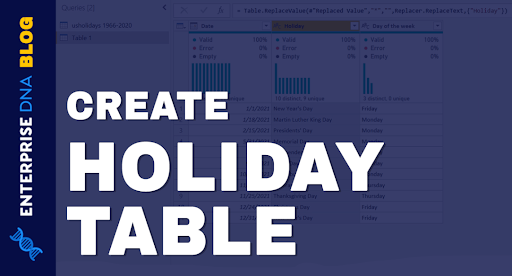
A calendar table helps display events, activities, plans, or appointments and can be added to any report or workbook design created in Power BI Desktop. It is an interactive way of displaying your data. We can also use a calendar table in an Excel workbook.
Why Choose Power BI To Create a Calendar Table?
1. The table in Power BI offers scrolling, zooming, and filtering capabilities. It also supports both date picker and range filters on the fly! That is achieved by using a slicer and table filters so that you can filter the entire data set by looking at the calendar table. You can also create A calendar table from various data sources. So if you have a large dataset to work with, it would be fantastic to have this option in Power BI.
2. The calendar table in Power BI is a step up from the older calendar table that Excel offers. The newer version can serve multiple purposes; you can use it as an event planner, activity planner, or even plan your vacation or holiday.
3. You can add content to your calendar table in numerous ways! You can attach images, create hyperlinks to other web pages, and look at the calendar table as an interactive timeline of events.
4. The calendar table in Power BI can be exported to Excel workbooks, PDFs, and Word documents. It can also be shared with others – even people who do not have or want to use Power BI.
5. You can use the table in Power BI in different ways; it can be used as a data source for a report or stored procedure.
6. You don't need to store the entire content of your calendar table – you only need to keep the data you want to see on your dashboard/report or workbook. It means you can have many records stored at one time and avoid storing unnecessary data.
7. If you do not have any data yet, the table in Power BI allows you to create your query to get information from the data source. The question will make and store data into your calendar table during its execution.
Perks of Using Power BI To Create a Calendar Table
1. Power BI can easily integrate with other applications and programs which are commonly used. So you can view your data in the calendar table using other programs or programs that aren't related to Power BI.
2. The calendar table in Power BI is interactive; you can use it as a navigation tool by selecting multiple items and taking action. For example, you could choose them for copying as a copied item and delete them from your database.
3. You can also filter your data by selecting the date – and then you will only receive the data from that date onwards; you don't need to keep scrolling through several days in your calendar table.
4. It's a great way of handling large amounts of data; if you are working with an enormous amount of data, then this is the way to go! You can create daily, weekly, or monthly views – so you won't need to try and keep track of a year in Power BI.
5. The calendar table in Power BI is a good technique for organizing data from numerous sources; you can use it to manage your company's various departments, locations, and employees. You could create separate views for different departments and locations. Then you need to add charts and other visuals to the dashboard or report – and your job is done!
6. You can store or share your data; you don't have to keep it all in Power BI, so you can distribute it where and when you want. That would encourage better collaboration between different departments.
7. It's possible to integrate the table in Power BI with other programs which are available online; for example, it is possible to hook up the data into your favorite social media accounts, such as Facebook and Twitter.
8. You don't need to filter out special days and holidays; you can leave them on your table, and your report will automatically highlight them.
9. No need to create multiple tables – Power BI allows you to create one standard calendar table, which we can use for anything! It's a simple yet effective way of saving data.
10. It is possible to export the content of the calendar table into various formats. You can save it in an Excel workbook, a PDF, or a Word document.
11. Remember that you don't always have to look at the table – there are other ways of displaying your data. For example, you could use the "Fast Timeline" in Power BI Desktop.
12. It is unlikely to encounter any problems with your database; the calendar table in Power BI is a reliable feature. It works well with an extensive database; you don't need to worry about your database size. It allows multiple people to work on the same report simultaneously.
Conclusion:
Using Power BI to create a calendar table is a simple yet effective way of organizing and maintaining your data. We can apply this technique in both Excel and Power BI Desktop so that you can keep your data contained and up to date – even if you are working on different projects simultaneously. It is an excellent way of collecting data, and you can achieve it without compromising the quality of your final report.

























